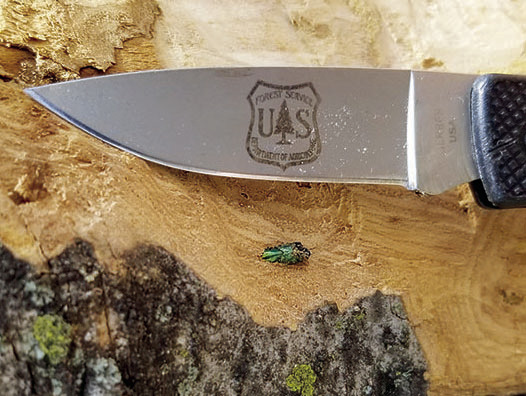COLLEGE STATION — The invasive emerald ash borer has been confirmed in Collin, Franklin, Johnson and Red River Counties. EAB is an invasive wood-boring pest of ash trees that has killed tens of millions of trees across 35 states since its arrival to the United States in 2002.
EAB was first detected in Texas in 2016 in Harrison County in northeast Texas. It has now been detected in 24 Texas counties, including positive confirmation just last month in Grayson, Hill, Hood, McLennan and Palo Pinto Counties.
“The continuous spread of EAB is a great concern for our ash tree population,” said Allen Smith, Texas A&M Forest Service Regional Forest Health Coordinator. “EAB has the potential to wipe out ash as a genus in North America, meaning no more ash trees period.”
Adult specimens were collected from Collin, Franklin, Johnson and Red River Counties in May and tentatively identified as EAB. Texas A&M Forest Service sent them to the USDA Department of Animal and Plant Health Inspection Service (APHIS) national lab for confirmatory identification. Lab results for both specimens tested positive as EAB.
Once the presence of EAB is confirmed in a county, the Texas Department of Agriculture (TDA) assumes regulatory responsibility including establishing quarantines. The state’s mandatory quarantine by TDA restricts the movement of any woody ash material exiting the county or quarantined area.
“Because EAB is transported unintentionally on firewood and wood products, the quarantine helps slow the beetle’s spread by restricting the movement of wood in and out of affected areas,” said Demian Gomez, Texas A&M Forest Service Regional Forest Health Coordinator.
Both healthy and stressed trees of all ash species are vulnerable to an EAB attack and have no natural resistance to the pest. Most trees will die within two to five years after infestation and without proper proactive measures, mortality can be 100% in areas, so early detection is key.
“There is no known way to stop the spread of EAB,” said Gomez. “But communities can minimize loss, diversify their tree species and increase the health and resiliency of urban forests.”
Texas A&M Forest Service has resources available to help affected communities identify signs of EAB infestation, as well as make decisions about preventative measures they can take and how to handle tree management and removal.
The agency will work with communities on state quarantines of the movement of wood into and out of the area. These quarantines are standard protocols with such infestations and in Texas are set by TDA.
For more information on EAB in Texas, visit http://texasforestservice. tamu.edu/eab/.
For information from TDA on EAB quarantine, visit https://texasagriculture. gov/RegulatoryPrograms/PlantQuality/ PestandDiseaseAlerts/EmeraldAshBorer. aspx.To report emerald ash borer, please call the EAB Hotline at 1-866-322-4512.

EAB is a destructive, non‐native, wood‐boring pest that targets ash trees. Native to Asia, forest health experts have been monitoring its movement across the United States since 2002. It has spread to more than half the states in America — and killed millions of ash trees. Courtesy photo



